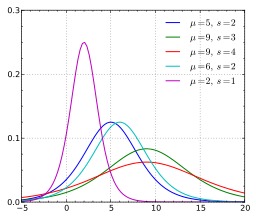There are many different bell shaped distributions in statistics. The most well known is the “bell curve“, formally called the normal distribution. However, the normal distribution isn’t the only bell shaped distribution—there are others, including:
- Hyperbolic Secant Distribution: symmetric member of the exponential family with a mean of 0 and variance of 1. It is similar to the normal distribution both in shape and symmetry but hyperbolic secant has slightly heavier tails [1].
- The logistic distribution also resembles a bell curve; it also has slightly heavier tails than the normal distribution. It appears in logistic regression and feedforward neural networks [2].
- The Cauchy distribution is also bell shaped but the mean and variance are not defined. The median is given by a location parameter θ, and the spread is given by a scale parameter &simga;. The Cauchy distribution occurs as the ratio of two independent standard normal random variables [2].
- A Gaussian mixture model is a probability distribution comprised of several weighted multivariate Gaussian (normal) distributions. The model is an overlapping of bell-shaped curves.

Properties of a Bell Shaped Distribution
A bell shaped distribution is named because it looks like the shape of a bell when plotted on a graph. These distributions share several important properties:
- A single peak in the center (i.e., they are unimodal distributions).
- Symmetry: If you draw a vertical line down the center of the graph, the left half will mirror the right.
References
PDF of the logistic distribution. Image: Krishnavedala| Wikimedia Commons
[1] M. J. Fischer, Generalized Hyperbolic Secant Distributions, 1
SpringerBriefs in Statistics, DOI: 10.1007/978-3-642-45138-6_1
[2] Ross, G. Probability/Density Distributions.
[3] Cunningham, A. Probability Playground: The Cauchy Distribution.